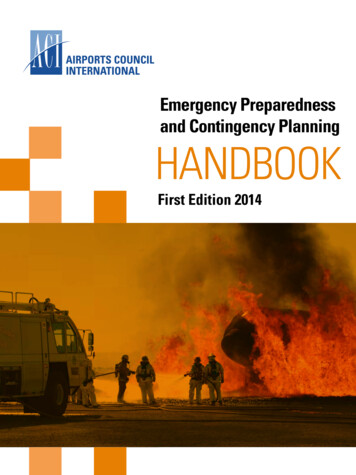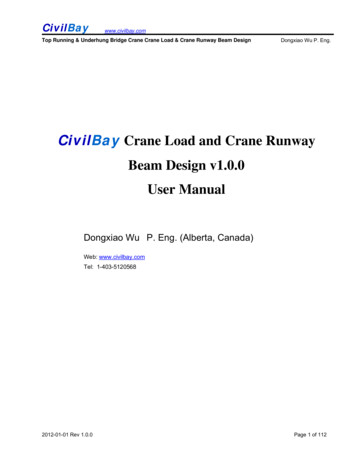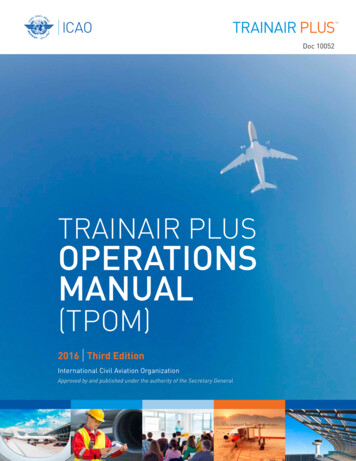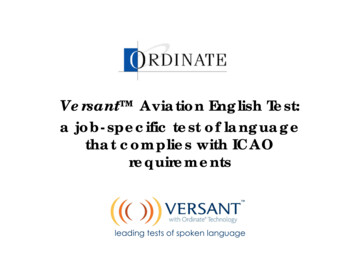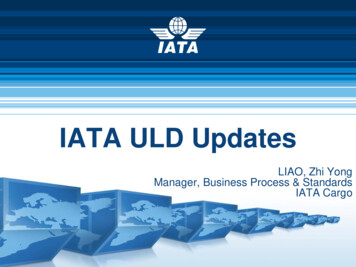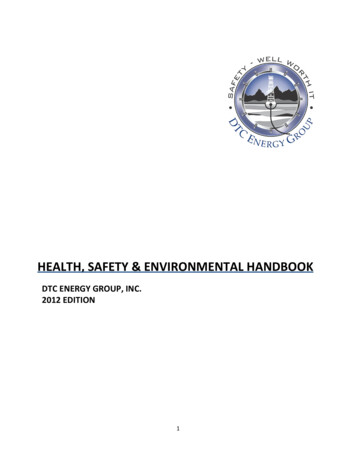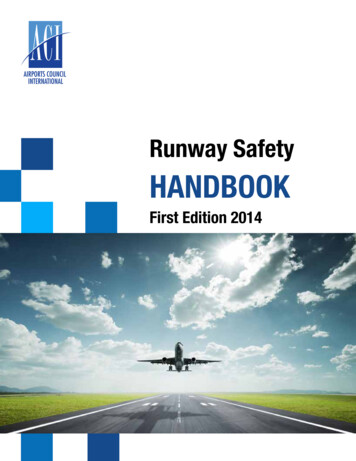
Transcription
Runway SafetyHANDBOOKFirst Edition 2014
Runway SafetyHANDBOOKFirst Edition 2014Authors: ACI World Safety & Technical Standing Committee (Subgroup)Written by: Dirk Geukens (Brussels Airport), Yair Gannot (Israel Airports Authority), GerhardGruber and Bernhard Winter (Vienna Airport), Rolf Liebscher (Fraport AG),Bruno Maingon (ADP), Gabriel Lesa (Kenneth Kaunda Airport - Lusaka), SergioIannaccone (Aeroporti di Roma), David Gamper and Paul Aliu (ACI World), John(Jong hoon) Kim (IIAC and ACI World)Reviewed by: Dirk Geukens (Brussels Airport), Eunbyul Kim and Songsup Lee (IIAC), IanWitter (Heathrow Airport), Thomas Romig (Geneva Airport), Gerhard Gruberand Bernhard Winter (Vienna Airport), Bruno Maingon and Jean-Noel Massot(ADP), SL Wong (ACI-APAC), David Gamper (ACI World)Coordinated by: John (Jong hoon) Kim (IIAC and ACI World)Published by:ACI World, Montreal, Canada
2014 Runway Safety HandbookDISCLAIMERThe information contained in this publication is subject to constant assessment in the light of changingrequirements and regulations. No subscriber or other reader should act on the basis of any such informationwithout referring to applicable laws and regulations and /or without obtaining appropriate professionaladvice. Although every effort has been made to ensure accuracy, Airports Council International (ACI) shallnot be held responsible for loss or damage caused by errors, omissions, misprints or misinterpretationof the contents hereof. Furthermore, ACI expressly disclaims all and any liability to any person, whethera purchaser of this publication or not, in respect of anything done or omitted, and the consequences ofanything done or omitted, by any such person through reliance on the contents of this publication.No part of the Runway Safety Handbook may be reproduced, recast, reformatted or transmitted in anyform by any means, electronic or mechanical, including photocopying, recording or use of any informationstorage and retrieval system, without prior written permission from:Director, Safety, TechnicalACI World800 rue de Square VictoriaSuite 1810, P.O Box 302Montreal, Quebec H4Z 1G8CanadaRunway Safety HandbookFirst Edition (2014)Copies of this publication are available from:Publications DepartmentAirports Council International800 rue de Square VictoriaSuite 1810, P.O Box 302Montreal, Quebec H4Z 1G8CanadaEmail: aci@aci.aeroWeb: www.aci.aeroISBN 2014 Airports Council International. All rights reserved.
2014 Runway Safety HandbookFOREWORDRunway safety is a significant challenge and a top priority forairport operations which is why ACI is proud to present thisnew handbook on Runway Safety, aimed at airport operators.Its content has been distilled from a wide range of guidancematerial from Civil Aviation Authorities, ACI Member Airports’operational safety procedures, ICAO and other internationalaviation organizations’ publications pertaining to runwaysafety.The content of this handbook also builds upon the existingguidance in the ACI Airside Safety Handbook (4th edition2010). While remaining short and succinct, the RunwaySafety Handbook provides checklists for action, as well as anexplanation of risks to be assessed and means of mitigationavailable. As stated in the text, local risk assessments areinevitably necessary.Safety on runways is clearly of great importance to AerodromeOperators, who want to avoid or mitigate all foreseeable risksof accidents occurring from runway incursion, excursion,confusion and FOD. These risks and issues have beendiscussed many times at ACI conferences and committeemeetings; therefore, ACI believes that it has the responsibilityto put forward a guide to best practice, to assist its members.The Runway Safety Handbook forms part of a coordinatedapproach to Safety Management Systems for ACI’s members.In the area of staff development, ACI’s Global Training offers arange of courses relevant to runway safety, via both classroomdelivery and online. Angela GittensDirector GeneralACI Worldi
2014 Runway Safety HandbookCONTENTSFOREWORD. iCONTENTS. iiINTRODUCTION. unway SafetyRunway Safety Team. 1Function of a Local Runway Safety Team. 1Reporting Culture. 1Establishing a Local Runway Safety Team. 1Terms of Reference and Actions. 2Hot Spots. 2Identification of Potential Runway Issues. 2ACI Recommended Training (Airport Perspective). 3Runway Safety Awareness. 3Change Management (Construction). 322.12.22.32.42.52.62.6.12.6.22.6.32.7Planning and DesignMaster Plan for New Infrastructure. 4Design of New Infrastructure. 5Planning and Redesign of Existing Infrastructure. 7Taxiway Naming Convention. 10Stop Bars. 11Visual Aids. 12Markings. 12Signs. 13Aerodrome Ground Lighting. 14RESAs. way Inspection. 16Wildlife Prevention. 19FOD Management. 19Obstacle Control. 20Establishment of OLS (Obstacle Limitation Surface). 20Procedures for Aerodrome Operators to Control OLS. 21Type A Charts. 21Communication/Surveillance. 22Radio Frequencies and ICAO Phraseology. 22
2014 Runway Safety p bars - communication procedures. 22Vehicle and Driver Training. 22Incident Reporting/Investigation/Statistics. 23Adverse Weather . 24Protection of Navigational Aids. 25AIS/AIP. 26AIRAC. 27Aeronautical Charts. 28Hot Spots Depiction in Aerodrome Chart. ntenance, Temporary Restriction and ConstructionMaintenance for Runway Safety. 29Maintenance – General. 29Surface Condition. 29Visual Aids and Non-Visual Aids. 30Removal of Contaminants. 32Drainage. 32Vegetation Control. 33Temporary Restriction. 33Declared Distance. 33Displaced Threshold. 35Dissemination of Information. 36Reduced RFF. 36Temporary Obstacles. 36ILS. 37Runway Closure. 37Construction Safety. 38Planning Construction. 38Preventive Activities for Construction Area (Restricted Area). 39Protection of Construction Area. 40Closing Construction and Reopening Runway. 40ABCDEAnnexesDefinitions. 42Acronyms. 43References. 44Frequently Asked Questions about RST. 45AIP & NOTAM Change Processes. 46iii
2014 Runway Safety HandbookINTRODUCTIONThe issues of Runway Incursions, Runway Excursions, Runway Confusions, FOD and Wildlife Managementhave been the most serious concerns related to runway safety. Over the past decade, these concerns havebeen addressed in conjunction with ICAO and others through the production of new best-practice materialsand more recently through ICAO’s runway safety programme, including a series of regional Runway SafetySymposia.The ACI World Safety and Technical Standing Committee (STSC) developed this Handbook to providemethodologies and best practices that can be implemented to assist airport operators to achieve a “state ofthe art” level of runway safety. This handbook provides guidance material for the development of a runwaysafety programme for all aerodrome (large or small) as well as ways to tailor, improve and expand existingprogrammes. The Handbook’s four chapters are focused on the perspective of aerodrome operators: R unway Safety describes how to establish a Runway Safety Team and implement a Runway SafetyProgramme; P lanning and Design explains how to prevent or mitigate infrastructural hazards of runway incursion,excursion and confusion during Master Planning and Designing; O perations provides methodologies of runway inspection, dissemination procedures for Aero-nauticalInformation Service (AIS) and best practices of FOD management and obstacle control; and M aintenance, Temporary Restriction and Construction provides proactive activities to prevent ormitigate accidents or incidents for those activities.The aim has been to produce a current ‘best practice’ guidance document without it being overly detailed.Therefore, of necessity, it cannot cover all situations. Further information is available from the expandedUseful Documents and Websites section at the end of this Handbook. These best industry practices, andmethodologies, should be implemented in a manner commensurate with the type and level of aircraftactivities at a particular airport.iv
2014 Runway Safety Handbook1Runway SafetyRunway excursions, incursions and confusionpresent some of the greatest aviation hazards,potentially creating very serious consequences. Anumber of fatal accidents have occurred around theworld resulting from these events.In recognition of the seriousness and growingfrequency of these events, a number of years agoICAO, the FAA and EUROCONTROL introducedconcerted programmes to reduce the numbers ofrunway incursions and excursions. One of theirconclusions was that a Local Runway Safety Teamshould be established at each airport. Additionalinformation can be found in the ICAO Doc 9870 Manual on the Prevention of Runway Incursions;3.1.11.1A runway incursion prevention programme should start with the establishment of runway safety teams atindividual aerodromes.Runway Safety TeamA Runway Safety Team is an essential part ofany airport runway safety programme. It is mostimportant to break down barriers between thedifferent operational organizations at the airport.Once these bodies treat each other as genuinepartners in runway safety, it is easier to shareawareness of safety issues identified at the airportand develop agreed solutions. Local RunwaySafety Teams may not necessarily replace existingcross-disciplinary teams such as an Airside SafetyCommittee, but should be integrated within theoverall safety plan for the airport.1.1.1F unction of a Local Runway SafetyTeam (LRST)The function of any successful Runway SafetyTeam will be to advise Airport Management andOperations Staff on: P revailing local conditions on the runway, taxiwaysand adjacent areas; Issues of concern and importance; and M itigating measures and solutions to identifiedissues.1.1.2Reporting CultureIt is of paramount importance that a clear, free andfair safety-reporting culture be established at theairport, especially a “just culture” in which individualsand their teams are aware that reporting mistakesor potentially unsafe actions and procedures willnot be punished, unless negligence was involved.Reporting of all safety-relevant events must bestrongly encouraged and valued. Without such asafety culture, Runway Safety Teams cannot haveaccess to all information on occurrences which maylead to potentially unsafe situations. All staff musthave constant and active awareness of the potentialfor error and the consequences of such errors.1.1.3E stablishing a Local Runway SafetyTeamThe team should consist of, as a minimum,representatives from at least the three main groupsassociated with manoeuvring area operations.Specifically, representatives from the AerodromeOperator, from the Air Navigation Service Providerand/or local Air Traffic Controllers and pilots fromAircraft Operators which operate at the aerodromemust be represented. In addition, any otherorganisations that operate on the manoeuvring areashould participate when applicable.1
2014 Runway Safety HandbookRepresentative ofAerodrome OperatorRepresentative ANSP orAir Traffic Service ProviderLocal Runway Safety Team(LRST)Other Stakeholder(Pilot and ATCassociations, etc.)Representative ofAircraft Operator (Airlines)Figure 1. Example of Composition of LRST1.1.4Terms of Reference and ActionsThe LRST will assist in enhancing runway safety byconducting the following tasks: R eview compliance of the aerodrome with ICAOSARPs in Annex 14; M onitor runway incidents by type, severity andfrequency of occurrence; Identify risk factors and local issues; I dentify particular locations where risks exist (“hotspots”); Identify problems in daily operations; S olicit assistance, e.g. advice and peer reviews,by safety experts from within the industry; C ontribute to active development of solutions tothese issues; E nsure that the best possible solution isimplemented; D isseminate information on developed solutionsto stakeholders; and I nitiate a comprehensive safety-awareness campaign to ensure that all stakeholders’ staffs areaware of safety issues.By identifying hot spots, it is easier for users of anairport to plan the safest possible paths of movementin and around that airport. Planning is a crucialsafety activity for airport users, pilots and air trafficcontrollers alike. By making sure that aircraft surfacemovements are planned and properly coordinatedwith air traffic control, pilots add another layer ofsafety to their flight preparations. Proper planninghelps avoid confusion by eliminating last-minutequestions and building familiarity with knownproblem. areas.1.1.6I dentification of Potential RunwayIssuesA Local Runway Safety Team will be able todraw on the combined operational experiencegained throughout the careers of its members, onindustry best practices through publications andestablished safety-information forums, as well asairport information. Local Runway Safety Teamsshould participate in industry meetings, in orderto assimilate the latest information and practices.Potential runway issues may entail: Design and maintenance of the runway; Markings, signs and lightings; Learning the lessons from other incidents1.1.5Hot SpotsA hot spot is defined as a location on an airportmovement area with a history of potential risk ofcollision or runway incursion, and where heightenedattention by pilots and drivers is necessary.2 S tandard operating procedures for airport staff –missing, inappropriate or incomplete procedures; Birds and wildlife; Foreign object debris (FOD); Incursions & excursions (by aircraft); and Incursions (other than by aircraft).
2014 Runway Safety Handbook1.1.7 ACI Recommended Training (AirportPerspective)Each individual member of the LRST should bequalified and should have received the best safetytraining possible in his/her sphere of expertise.APEX In Safety also recommends that LRSTmembers obtain safety training in other sphereswhich may overlap with their own, within the areaof operations. We recommend that each membermaintain competency in each of the following: A CI Runway Incursion Awareness and Preventioncourse; ACI Global Safety Network (GSN); and ACI/ICAO Aerodrome Certification course.Please visit www.aci.aero/training for further information on relevant safety training courses.1.2Runway Safety AwarenessAn important objective for Local Runway SafetyTeams is to raise awareness of runway safetymatters and share good practices to prevent runwayincursions, excursions, wildlife events, vehicle andmobile equipment occurrences.1.3Change Management (Construction)Runway construction or temporary restrictionsfor maintenance may create hazards for aircraftoperation. It is recommended that the RST shouldundertake a safety assessment at each stage of theplanning of the construction or maintenance.Planning Stage: The construction plan (or long termmaintenance plan) should be reported to the LRSTand the LRST should perform a safety assessmentvia document to review such items as: T he construction site protection plan (includingmarkings, signs and lighting); T he construction site access plan (including thecommunication plan to ATC); P rescriptive traffic control plans, including phasingpredicated on aircraft access; and The Aeronautical Information plan (AIP or NOTAM).Initial Construction Stage: the LRST should performa safety assessment through site inspection anddocument review before beginning construction, toreview such items as: P rotection of the construction site and measurements according to the plan;A local safety awareness campaign should beinitiated at each aerodrome to identify runway safetyissues from the combined operational experience ofthe established Local Runway Safety Team. Timingof awareness campaigns is important. Making a hotspot map or conducting a runway safety briefing atthe start of a busy season, or just before a periodof weather deterioration, can be helpful to alloperational staff. P rotection measurement from local potentialhazards; andLessons learned from LRST experience, the individualcareers of its members, and industry best practicesfrom publications and safety campaigns should begathered for information-sharing to all members. ALRST should ensure wide dissemination of the safetyrecommendations derived from accident and incidentinvestigation findings as well as other relevant lessonslearned, for example from operational experience andbest risk-mitigation practices. C learance of construction fencing, stationaryequipment and vehicles, etc. from the site The published AIP or NOTAM.Closing Construction and Reopening Stage: theLRST should perform a safety assessment throughsite inspection and document review before closingthe construction site and reopening the runway, tocheck items such as: C ompliance of the constructed area’s markings,signs and lighting with ICAO SARPs; and The revision of the AIP or NOTAM.More information about preparation for constructionsafety can be found in Chapter 4.3
2014 Runway Safety Handbook2 Planning and DesignThe principal concept for aerodrome planningis to provide sufficient aerodrome capacity andoptimize operational efficiency without adverselyaffecting safety. Aerodrome design has traditionallybeen mainly concerned with the issues of safetyand security. However, operational efficiency andenvironmental protection have gradually becomeequally important factors. Additionally, most airportsare facing restrictions to their development.ICAO SARPs, guidance materials, and each State’sregulations for aerodrome infrastructure and facilitiesmust be respected, together with local restrictions.Restrictions such as the land usage plan, crosswind,noise, and environmental and economic issuesmay cause difficulties in fulfilling all the regulatoryrequirements for the aerodrome. This chapter mainlycovers infrastructural safety issues which need to betaken into account to enhance runway safety.2.1Master Plan for New InfrastructureThe Airport Master Plan is a document that presentsthe short-term (1-5 years), intermediate-term (610 years) and long-term (10-20 year) developmentgoals of an airport and is typically evaluated andupdated every 5 to 10 years. The Airport MasterPlan provides the following: A graphic presentation of the future developmentof the airport and anticipated land uses in thevicinity of the airport; A schedule for development; An achievable financial plan; J ustification for the plan technically and procedurally; and A n implementation plan that satisfies local, state,and federal regulations.The Master Plan should be reviewed at leastannually and adjusted as appropriate to reflectconditions at the time of review. It should bethoroughly evaluated and modified every five years,or more often if changes in economic, operational,environmental and financial condition indicate anearlier need for such revision. It is recommendedthat the aerodrome operator should be proactivelyinvolved in the master planning to eliminate potentialhazards being created by aerodrome infrastructure,such as the runway and taxiway layout, etc., and toaccommodate future aircraft developments.MASTER PLANNING PROCESSPre PlanningFacility RequirementPublic InvolvementAlternative Development & EvalutationAviation ForecastsEnvironmental ConsiderationInventory of Existing ConditionFinancial Feasibility AnalysisAirport Layout PlanFigure 2. Example of Master Planning process4
2014 Runway Safety Handbook2.2Design of New InfrastructureIt is critical for the success of the aerodrome for itto produce a Master Plan. This should be based ona series of broad concepts of how the aerodromewill need to develop over a given time. This planwill need to be the subject of comprehensiveconsultation and general agreement by theplanning team. A Master Plan can take the formof a simple listing of objectives and projects, orat the other end of the scale may be a complexset of documents produced by a dedicatedplanning team and using inputs from all parts ofthe business. The Master Plan should embody thefollowing general characteristics:New aerodrome infrastructure design should fullycomply with ICAO SARPs and State regulations.Even though complying with SARPs, many airports have complicated hazards inherent to theirinfrastructure, such as: S afety must feature as one of the Key MasterPlanning Objectives; and a requirement forsafety assessments for all developments shouldbe formally expressed. This should be reflectedin the aerodrome’s Safety Management System; O ne or more taxiways connecting to convergingrunways. T he plan needs to take into account forecastdemand for a range of aerodrome activitiesincluding traffic levels, passenger numbers,freight throughput and the maintenance orimprovement of service levels, together withany special requirements applicable to the aerodrome; T he plan should cover a fixed timescale depending on aerodrome needs and expected futureevents. Within the life of the plan there should befixed milestones for review and to commencedevelopment of the succeeding plan; T he plan should have flexibility, with arrangements in place for review and updating to meetchanging situations; and T he plan should act as the focal point of planningactivity, so that developments flow from it in anordered and coordinated fashion. Every projectshould be considered within the context of thewhole plan. All too often, projects completed inisolation have precluded later development orresulted in limited choice and/or an erosion ofsafety standards. Cross runways; Converging runways; C losely spaced parallel runways with rapid exittaxiway leading directly to another runway; Y-shaped taxiway intersections; Taxiways crossing a rapid exit taxiway; andThe primary focus of the design of the runway areasof an airport should be safety and efficiency ofoperation. Clearly, the reduction of potential runwayincursions is an integral part of this goal and soincursion prevention measures should be a part ofthe design of new runways and taxiways.Key elements to eliminate incursion risk airportdesign are: C ross Runways and Converging Runwaysshould be avoided because they usually requirecomplicated connecting taxiways and also restrictflight operations. But crosswind is one of the mostimportant factors of the runway layout. Aerodromeoperators should perform a careful studyanalysing prevailing winds and the performanceof the aircraft that will be accommodated on thenew runways. If cross or converging runways areinevitable, aerodrome operators should prepareprevention measures for runway incursion. Suchrunways
The Runway Safety Handbook forms part of a coordinated approach to Safety Management Systems for ACI’s members. In the area of staff development, ACI’s Global Training offers a range of courses relevant to runway safety, via both classroom deliv
